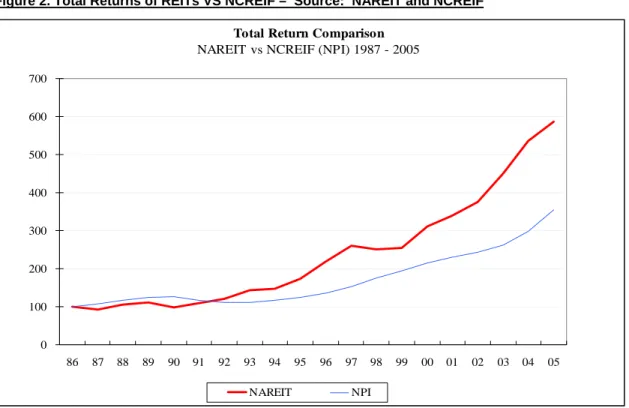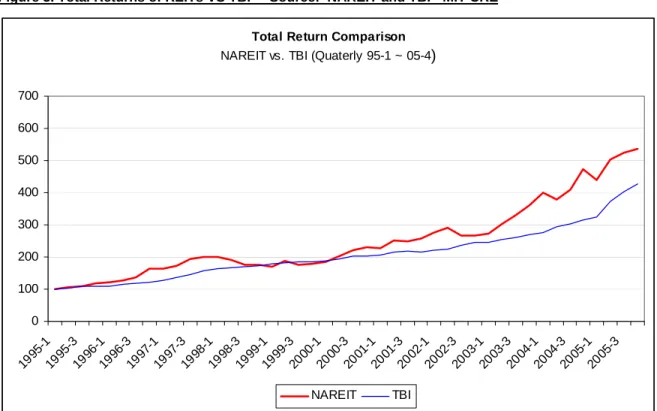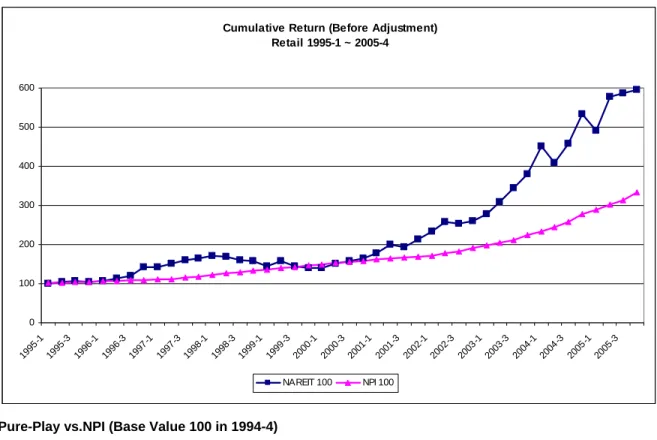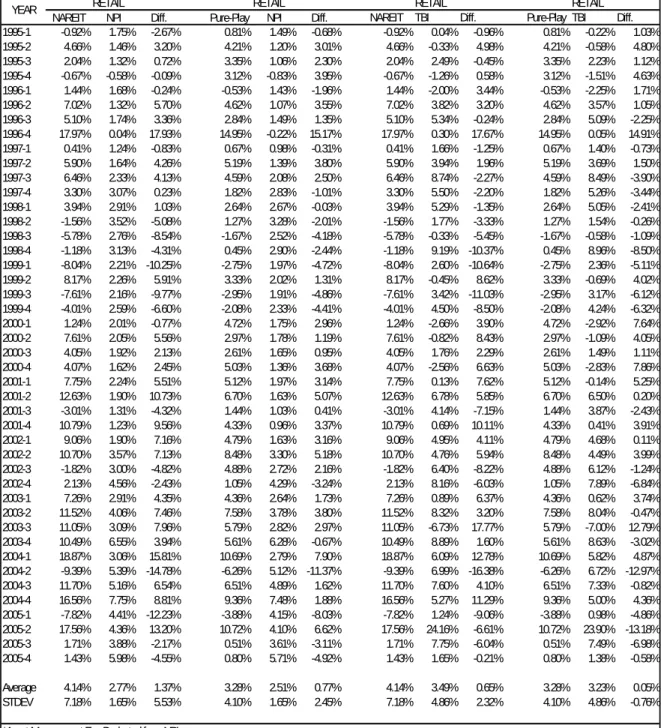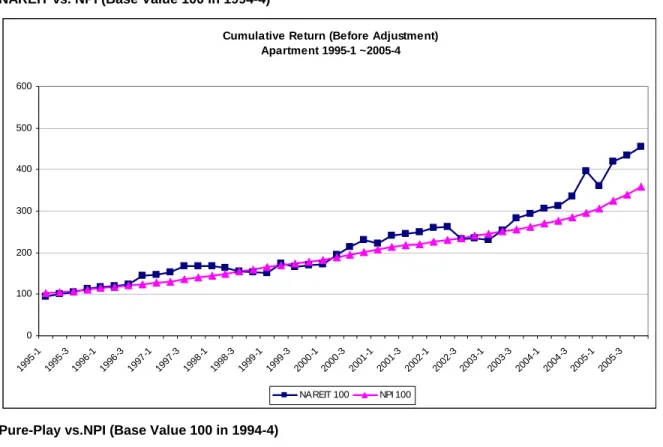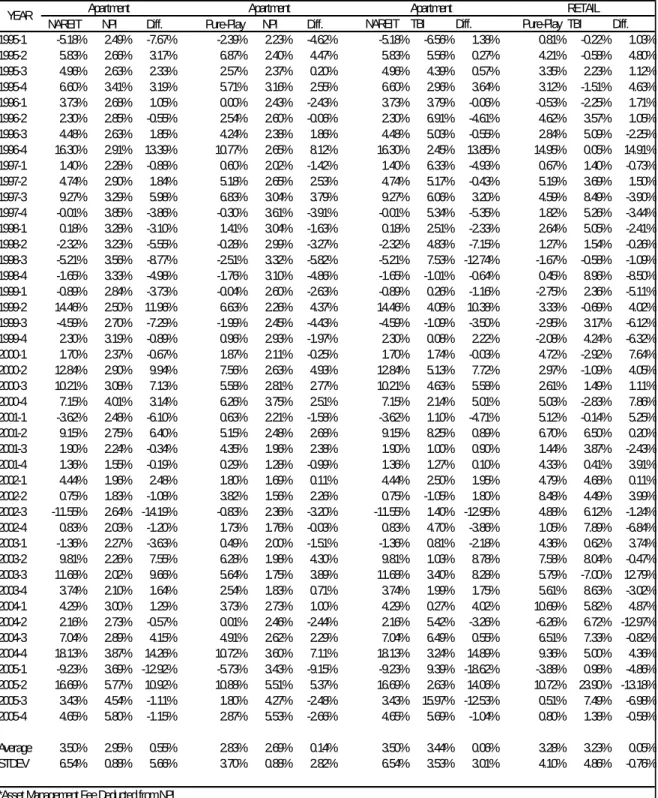3.7 Treatment of Management Expenses and Fees
Private Market Index:
NPI returns include asset management that fees paid by investors. In this thesis, NCREIF
Fund Index – Historical. The Open End Diversified Core Equity Management Fee ratio was
used as an approximation of asset management fees and deducted from NPI and TBI
returns in each quarter.
Public Market Index:
REIT investment fees paid by the investors are approximated by Historical annual data of
Vanguard REIT Fund expense ratios. The annual returns were only available so the data
was spread out to approximate quarterly expense ratios, then deducted from Pure-Play
REIT returns.
Table 3. NFI-ODCE Management Fee Table 4. Vanguard REIT Index Fund Expense
Fee Ratio
1995 1 0.26%
1995 2 0.26%
1995 3 0.26%
1995 4 0.25%
1996 1 0.25%
1996 2 0.25%
1996 3 0.25%
1996 4 0.26%
1997 1 0.26%
1997 2 0.25%
1997 3 0.25%
1997 4 0.24%
1998 1 0.24%
1998 2 0.24%
1998 3 0.24%
1998 4 0.23%
1999 1 0.24%
1999 2 0.24%
1999 3 0.25%
1999 4 0.26%
2000 1 0.26%
2000 2 0.27%
2000 3 0.27%
2000 4 0.26%
2001 1 0.27%
2001 2 0.27%
2001 3 0.28%
2001 4 0.27%
2002 1 0.27%
2002 2 0.27%
2002 3 0.28%
2002 4 0.27%
2003 1 0.27%
2003 2 0.28%
2003 3 0.27%
2003 4 0.27%
2004 1 0.27%
2004 2 0.27%
2004 3 0.27%
2004 4 0.27%
2005 1 0.26%
2005 2 0.26%
2005 3 0.27%
Year
Expense Ratio
1995 1 0.09%
1995 2 0.09%
1995 3 0.09%
1995 4 0.09%
1996 1 0.09%
1996 2 0.09%
1996 3 0.09%
1996 4 0.09%
1997 1 0.06%
1997 2 0.06%
1997 3 0.06%
1997 4 0.06%
1998 1 0.06%
1998 2 0.06%
1998 3 0.06%
1998 4 0.06%
1999 1 0.07%
1999 2 0.07%
1999 3 0.07%
1999 4 0.07%
2000 1 0.08%
2000 2 0.08%
2000 3 0.08%
2000 4 0.08%
2001 1 0.08%
2001 2 0.08%
2001 3 0.08%
2001 4 0.08%
2002 1 0.07%
2002 2 0.07%
2002 3 0.07%
2002 4 0.07%
2003 1 0.06%
2003 2 0.06%
2003 3 0.06%
2003 4 0.06%
2004 1 0.06%
2004 2 0.06%
2004 3 0.06%
2004 4 0.06%
2005 1 0.05%
2005 2 0.05%
2005 3 0.05%
2005 4 0.05%
Year
Figure 4. Retail Sector Return Performance Cobmparisons - Plots
NAREIT vs. NPI (Base Value 100 in 1994-4) Quaterly
Cumulative Return (Before Adjustment)
Retail 1995-1 ~ 2005-4
0
100
200
300
400
500
600
1995
-1
1995
-3
1996
-1
1996
-3
1997
-1
1997
-3
1998
-1
1998
-3
1999
-1
1999
-3
200
0-1
2000
-3
2001
-1
2001
-3
2002
-1
2002
-3
200
3-1
2003
-3
2004
-1
2004
-3
2005
-1
2005
-3
NAREIT 100 NPI 100
Pure-Play vs.NPI (Base Value 100 in 1994-4)
Cumulative Return (After Adjustment)
Retail 1995-1 ~ 2005-4
0
100
200
300
400
500
600
1995
-1
1995
-3
1996
-1
1996
-3
1997
-1
1997
-3
1998
-1
1998
-3
1999
-1
1999
-3
2000
-1
200
0-3
2001
-1
200
1-3
2002
-1
200
2-3
2003
-1
200
3-3
2004
-1
200
4-3
2005
-1
200
5-3
PurePlay 100 NPI 100
NAREIT vs. TBI (Base Value 100 in 1994-4)
Cumulative Return (Before Adjustment)
Retail 1995-1 ~ 2005-4
0
100
200
300
400
500
600
1995
-1
199
5-3
1996
-1
1996
-3
1997
-1
1997
-3
199
8-1
1998
-3
1999
-1
1999
-3
200
0-1
200
0-3
2001
-1
2001
-3
2002
-1
200
2-3
200
3-1
2003
-3
2004
-1
2004
-3
200
5-1
200
5-3
NAREIT 100 TBI 100
Pure-Play vs. TBI (Base Value 100 in 1994-4)
Cumulative Return (After Adjustment)
Retail 1995-1 ~2005-4
0
100
200
300
400
500
600
1995
-1
1995
-3
1996
-1
199
6-3
199
7-1
1997
-3
1998
-1
1998
-3
199
9-1
1999
-3
2000
-1
2000
-3
2001
-1
200
1-3
2002
-1
2002
-3
2003
-1
200
3-3
200
4-1
2004
-3
2005
-1
2005
-3
PurePlay 100 TBI 100
Figure 5. Apartment Sector Return Performance Comparisons – Plots
NAREIT vs. NPI (Base Value 100 in 1994-4)
Cumulative Return (Before Adjustment)
Apartment 1995-1 ~2005-4
0
100
200
300
400
500
600
1995
-1
1995
-3
1996
-1
1996
-3
1997
-1
1997
-3
1998
-1
1998
-3
1999
-1
1999
-3
2000
-1
2000
-3
2001
-1
2001
-3
2002
-1
2002
-3
2003
-1
2003
-3
2004
-1
2004
-3
2005
-1
2005
-3
NAREIT 100 NPI 100
Pure-Play vs.NPI (Base Value 100 in 1994-4)
Cumulative Return (After Adjustments)
Apartments 1995-1 ~ 2005-4
0
100
200
300
400
500
600
1995
-1
1995
-3
1996
-1
1996
-3
1997
-1
1997
-3
1998
-1
1998
-3
1999
-1
1999
-3
2000
-1
2000
-3
2001
-1
2001
-3
2002
-1
2002
-3
2003
-1
2003
-3
2004
-1
2004
-3
2005
-1
2005
-3
PurePlay 100 NPI 100
NAREIT vs. TBI (Base Value 100 in 1994-4)
Cumulative Return (Before Adjustment)
Apartment 1995-1 ~ 2005-4
0
100
200
300
400
500
600
1995
-1
1995
-3
1996
-1
199
6-3
1997
-1
1997
-3
1998
-1
1998
-3
199
9-1
1999
-3
2000
-1
2000
-3
2001
-1
200
1-3
2002
-1
2002
-3
2003
-1
2003
-3
200
4-1
2004
-3
2005
-1
2005
-3
NAREIT 100 TBI 100
Pure-Play vs. TBI (Base Value 100 in 1994-4)
Cumulative Return (After Adjustment)
Apartment 1995-1 ~2005-4
0
100
200
300
400
500
600
1995
-1
1995
-3
1996
-1
1996
-3
1997
-1
1997
-3
1998
-1
1998
-3
1999
-1
1999
-3
2000
-1
2000
-3
2001
-1
2001
-3
2002
-1
2002
-3
2003
-1
2003
-3
2004
-1
2004
-3
2005
-1
2005
-3
PurePlay 100 TBI 100
Figure 6. Office Sector Return Performance Comparisons – Plots
NAREIT vs. NPI (Base Value 100 in 1994-4)
Cumulative Returns (Before Adjustment)
Office 1995-1 ~ 2005-4
0
100
200
300
400
500
600
1995
-1
1995
-3
1996
-1
1996
-3
1997
-1
199
7-3
1998
-1
1998
-3
1999
-1
1999
-3
200
0-1
2000
-3
2001
-1
2001
-3
2002
-1
2002
-3
2003
-1
2003
-3
200
4-1
2004
-3
2005
-1
2005
-3
NAREIT 100 NPI 100
Pure-Play vs.NPI (Base Value 100 in 1994-4)
Cumulative Return (Before Adjustment)
Office 1995-1 ~2005-4
0
100
200
300
400
500
600
1995
-1
1995
-3
1996
-1
1996
-3
1997
-1
1997
-3
1998
-1
1998
-3
1999
-1
1999
-3
2000
-1
2000
-3
2001
-1
2001
-3
2002
-1
2002
-3
2003
-1
2003
-3
2004
-1
2004
-3
2005
-1
2005
-3
NAREIT 100 NPI 100
NAREIT vs. TBI (Base Value 100 in 1994-4)
Cumulative Return (Before Adjustment)
Office 1995-1 ~ 2005-4
0
100
200
300
400
500
600
1995
-1
1995
-3
1996
-1
1996
-3
1997
-1
1997
-3
1998
-1
1998
-3
1999
-1
1999
-3
2000
-1
2000
-3
2001
-1
2001
-3
2002
-1
2002
-3
2003
-1
2003
-3
2004
-1
2004
-3
2005
-1
2005
-3
NAREIT 100 TBI 100
Pure-Play vs. TBI (Base Value 100 in 1994-4)
Cumulative Return (After Adjustment)
Office 1995-1 ~ 2005-4
0
100
200
300
400
500
600
1995
-1
1995
-3
1996
-1
1996
-3
1997
-1
1997
-3
1998
-1
1998
-3
1999
-1
1999
-3
2000
-1
2000
-3
2001
-1
2001
-3
2002
-1
2002
-3
2003
-1
2003
-3
2004
-1
2004
-3
2005
-1
2005
-3
PurePlay 100 TBI 100
Figure 7. Industrial Sector Return Performance Comparisons – Plots
NAREIT vs. NPI (Base Value 100 in 1994-4)
Cumulative Retruns (Before Adjustment)
Industrial 1995-1 ~ 2005-4
0
100
200
300
400
500
600
199
5-1
199
5-3
199
6-1
199
6-3
199
7-1
19
97-3
199
8-1
199
8-3
199
9-1
19
99-3
200
0-1
2000
-3
200
1-1
200
1-3
200
2-1
200
2-3
20
03-1
200
3-3
2004
-1
200
4-3
200
5-1
200
5-3
NAREIT 100 NPI 100
Pure-Play vs.NPI (Base Value 100 in 1994-4)
Cumulative Return (After Adjustment)
Industrial 1995-1 ~ 2005-4
0
100
200
300
400
500
600
1995
-1
1995
-3
19
96-1
1996
-3
1997
-1
19
97-3
19
98-1
1998
-3
19
99-1
19
99-3
2000
-1
2000
-3
20
01-1
2001
-3
2002
-1
20
02-3
2003
-1
2003
-3
20
04-1
2004
-3
2005
-1
20
05-3
PurePlay 100 NPI 100
NAREIT vs. TBI (Base Value 100 in 1994-4)
Cumulative Return (Before Adjustment)
Industrial 1995-1 ~ 2005-4
0
100
200
300
400
500
600
1995
-1
1995
-3
1996
-1
1996
-3
1997
-1
1997
-3
1998
-1
199
8-3
199
9-1
199
9-3
200
0-1
200
0-3
2001
-1
2001
-3
2002
-1
2002
-3
2003
-1
2003
-3
2004
-1
2004
-3
2005
-1
2005
-3
NAREIT 100 TBI 100
Pure-Play vs. TBI (Base Value 100 in 1994-4)
Cumulative Return (After Adjustment)
Industrial 1995-1 ~ 2005-4
0
100
200
300
400
500
600
1995
-1
1995
-3
19
96-1
1996
-3
1997
-1
19
97-3
19
98-1
1998
-3
1999
-1
19
99-3
2000
-1
2000
-3
20
01-1
2001
-3
2002
-1
20
02-3
20
03-1
2003
-3
2004
-1
20
04-3
2005
-1
2005
-3
PurePlay 100 TBI 100

